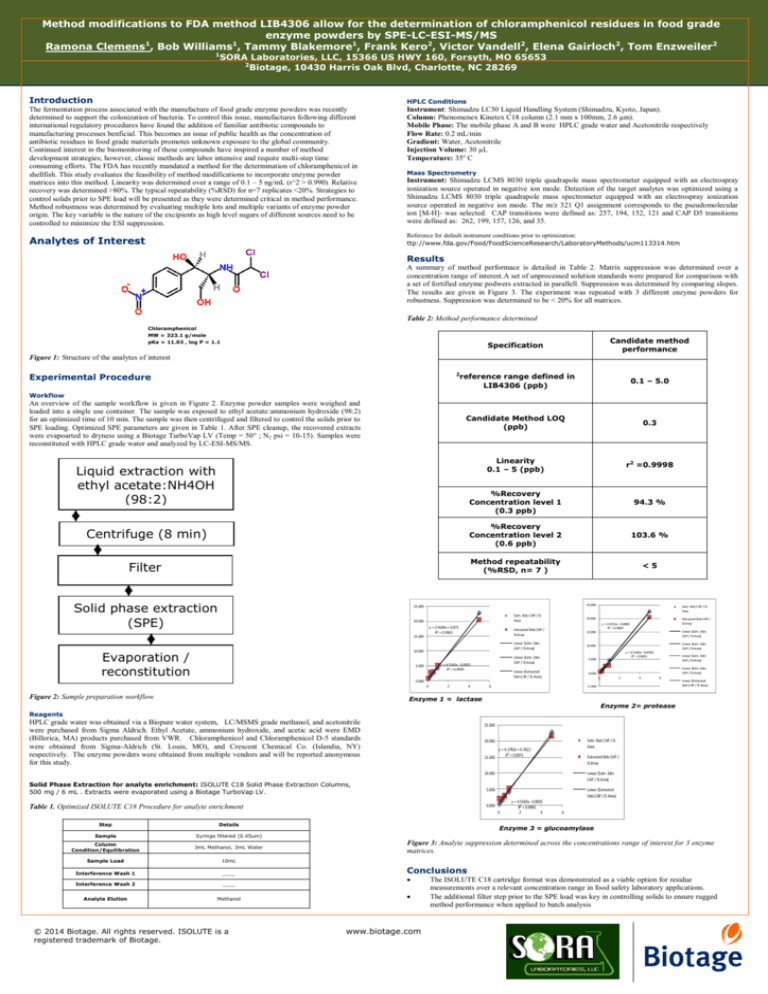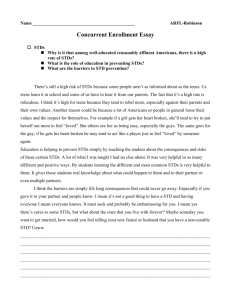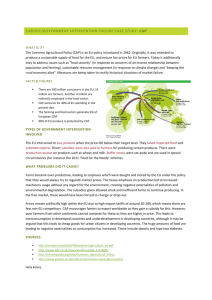
Method modifications to FDA method LIB4306 allow for the determination of chloramphenicol residues in food grade
enzyme powders by SPE-LC-ESI-MS/MS
Ramona Clemens1, Bob Williams1, Tammy Blakemore1, Frank Kero2, Victor Vandell2, Elena Gairloch2, Tom Enzweiler2
1
SORA Laboratories, LLC, 15366 US HWY 160, Forsyth, MO 65653
2
Biotage, 10430 Harris Oak Blvd, Charlotte, NC 28269
Introduction
HPLC Conditions
The fermentation process associated with the manufacture of food grade enzyme powders was recently
determined to support the colonization of bacteria. To control this issue, manufactures following different
international regulatory procedures have found the addition of familiar antibiotic compounds to
manufacturing processes benficial. This becomes an issue of public health as the concentration of
antibiotic residues in food grade materials promotes unknown exposure to the global community.
Continued interest in the biomonitoring of these compounds have inspired a number of method
development strategies; however, classic methods are labor intensive and require multi-step time
consuming efforts. The FDA has recently mandated a method for the determination of chloramphenicol in
shellfish. This study evaluates the feasibility of method modifications to incorporate enzyme powder
matrices into this method. Linearity was determined over a range of 0.1 – 5 ng/mL (r^2 > 0.990). Relative
recovery was determined >80%. The typical repeatability (%RSD) for n=7 replicates <20%. Strategies to
control solids prior to SPE load will be presented as they were determined critical in method performance.
Method robustness was determined by evaluating multiple lots and multiple variants of enzyme powder
origin. The key variable is the nature of the excipients as high level sugars of different sources need to be
controlled to minimize the ESI suppression.
Instrument: Shimadzu LC30 Liquid Handling System (Shimadzu, Kyoto, Japan).
Column: Phenomenex Kinetex C18 column (2.1 mm x 100mm, 2.6 µm).
Mobile Phase: The mobile phase A and B were HPLC grade water and Acetonitrile respectively
Flow Rate: 0.2 mL/min
Gradient: Water, Acetonitrile
Injection Volume: 30 µL
Temperature: 35o C
Analytes of Interest
Reference for default instrument conditions prior to optimization:
ttp://www.fda.gov/Food/FoodScienceResearch/LaboratoryMethods/ucm113314.htm
Mass Spectrometry
Instrument: Shimadzu LCMS 8030 triple quadrapole mass spectrometer equipped with an electrospray
ionization source operated in negative ion mode. Detection of the target analytes was optimized using a
Shimadzu LCMS 8030 triple quadrapole mass spectrometer equipped with an electrospray ionization
source operated in negative ion mode. The m/z 321 Q1 assignment corresponds to the pseudomolecular
ion [M-H]- was selected. CAP transitions were defined as: 257, 194, 152, 121 and CAP D5 transitions
were defined as: 262, 199, 157, 126, and 35.
Results
A summary of method performace is detailed in Table 2. Matrix suppression was determined over a
concentration range of interest.A set of unprocessed solution standards were prepared for comparison with
a set of fortified enzyme podwers extracted in parallell. Suppression was determined by comparing slopes.
The results are given in Figure 3. The experiment was repeated with 3 different enzyme powders for
robustness. Suppression was determined to be < 20% for all matrices.
Table 2: Method performance determined
Chloramphenicol
MW = 323.1 g/mole
pKa = 11.03 , log P = 1.1
Specification
Candidate method
performance
reference range defined in
LIB4306 (ppb)
0.1 – 5.0
Candidate Method LOQ
(ppb)
0.3
Linearity
0.1 – 5 (ppb)
r2 =0.9998
%Recovery
Concentration level 1
(0.3 ppb)
94.3 %
Centrifuge (8 min)
%Recovery
Concentration level 2
(0.6 ppb)
103.6 %
Filter
Method repeatability
(%RSD, n= 7 )
<5
Figure 1: Structure of the analytes of interest
2
Experimental Procedure
Workflow
An overview of the sample workflow is given in Figure 2. Enzyme powder samples were weighed and
loaded into a single use container. The sample was exposed to ethyl acetate:ammonium hydroxide (98:2)
for an optimized time of 10 min. The sample was then centrifuged and filtered to control the solids prior to
SPE loading. Optimized SPE parameters are given in Table 1. After SPE cleanup, the recovered extracts
were evapoarted to dryness using a Biotage TurboVap LV (Temp = 50° ; N2 psi = 10-15). Samples were
reconstituted with HPLC grade water and analyzed by LC-ESI-MS/MS.
Liquid extraction with
ethyl acetate:NH4OH
(98:2)
(shake for 10 min)
Solid phase extraction
(SPE)
25.000
25.000
20.000
y = 3.9189x + 0.871
R² = 0.9963
15.000
10.000
Evaporation /
reconstitution
y = 4.5543x - 0.0835
R² = 0.9995
5.000
Soln. Stds CAP / IS
Area
20.000
Extracted Stds CAP /
IS Area
15.000
Linear (Soln. Stds
CAP / IS Area)
10.000
Linear (Soln. Stds
CAP / IS Area)
5.000
Linear (Extracted
Stds CAP / IS Area)
0.000
Figure 2: Sample preparation workflow
2
4
Extracted Stds CAP /
IS Area
y = 4.5531x - 0.0895
R² = 0.9997
6
Linear (Soln. Stds
CAP / IS Area)
Linear (Soln. Stds
CAP / IS Area)
y = 4.2183x - 0.6493
R² = 0.9951
Linear (Soln. Stds
CAP / IS Area)
Linear (Soln. Stds
CAP / IS Area)
0
0.000
0
Soln. Stds CAP / IS
Area
2
4
6
-5 .000
Linear (Extracted
Stds CAP / IS Area)
Enzyme 1 = lactase
Enzyme 2= protease
Reagents
HPLC grade water was obtained via a Biopure water system, LC/MSMS grade methanol, and acetonitrile
were purchased from Sigma Aldrich. Ethyl Acetate, ammonium hydroxide, and acetic acid were EMD
(Billerica, MA) products purchased from VWR. Chloramphenicol and Chloramphenicol D-5 standards
were obtained from Sigma-Aldrich (St. Louis, MO), and Crescent Chemical Co. (Islandia, NY)
respectively. The enzyme powders were obtained from multiple vendors and will be reported anonymous
for this study.
25.000
Soln. Stds CAP / IS
Area
20.000
15.000
y = 4.1782x + 0.7612
R² = 0.9971
Extracted Stds CAP /
IS Area
Linear (Soln. Stds
CAP / IS Area)
10.000
Solid Phase Extraction for analyte enrichment: ISOLUTE C18 Solid Phase Extraction Columns,
500 mg / 6 mL . Extracts were evaporated using a Biotage TurboVap LV.
5.000
0.000
Table 1. Optimized ISOLUTE C18 Procedure for analyte enrichment
Step
0
Details
Sample
Syringe filtered (0.45um)
Column
Condition/Equilibration
3mL Methanol, 3mL Water
Sample Load
10mL
Interference Wash 1
____
Interference Wash 2
____
Analyte Elution
Methanol
© 2014 Biotage. All rights reserved. ISOLUTE is a
registered trademark of Biotage.
Linear (Extracted
Stds CAP / IS Area)
y = 4.5543x - 0.0835
R² = 0.9995
2
4
6
Enzyme 3 = glucoamylase
Figure 3: Analyte suppression determined across the concentrations range of interest for 3 enzyme
matrices.
Conclusions
www.biotage.com
The ISOLUTE C18 cartridge format was demonstrated as a viable option for residue
measurements over a relevant concentration range in food safety laboratory applications.
The additional filter step prior to the SPE load was key in controlling solids to ensure rugged
method performance when applied to batch analysis






